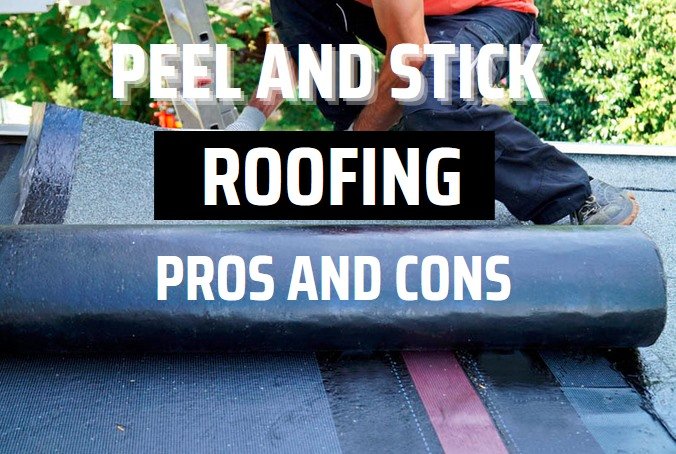Here, we present our guide on peel and stick roofing pros and cons, which covers its definition, application to flat and metal roofs, durability, value, and removal.
After weighing the advantages and disadvantages of self-adhered roofing, it is evident that the advantages exceed the disadvantages. However, working with a professional is still crucial. A professional can evaluate if self-adhered roofing is appropriate for your house or company.
Peel and stick roof underlayment, a revolutionary type of roofing material, is currently on-trend, particularly in hot, humid climates. This type of underlayment is gaining popularity due to its ease of installation and durability.
A key advantage of peel-and-stick underlayment for roofs is its enhanced durability compared to conventional underlayment, making it an excellent choice for protecting roof decking from environmental elements.
Read also: Problems With Synthetic Roof Underlayment

What Is Peel And Stick Roofing
In cold weather conditions, film-capped peel-and-stick underlayment outperforms granular membranes due to its more potent adhesive, which adheres effectively even at lower temperatures. The practicality of peel-and-stick roofing materials is evident in their lightweight nature, allowing for easy folding and fitting into small spaces and around edges.
This flexibility simplifies handling and installation, making it a preferred choice for contractors and homeowners alike.
The tiles won’t link together because the plastic surface stops the adhesive layer from coming into touch with them. Some believe that membranes with plastic surfaces are more slippery than those with granular surfaces.
Peel And Stick Roofing Material
High-density polyethene or polyester, both rubberized polymer mixes, are used to create peel-and-stick underlayment. This material is more resilient to tears than conventional felt, thanks to its flexibility.
Peel and stick underlayment serves as a robust barrier, significantly reducing the risk of damage to the roof caused by environmental factors like ice dams and wind-driven rain. It increases the lifespan of your roof since it is more durable than the felt underlayment.
Read also: What Does TPO Roofing Stand For?
This underlayment doesn’t wrinkle, which results in a waterproof barrier that eliminates any potential entry points for water. An added benefit is that this underlayment doesn’t require nailing, simplifying the installation process and reducing labour time.
Pros
- Environmentally Friendly
Among the advantages of peel-and-stick roof underlayment is its eco-friendliness. This roofing solution not only provides superior protection but also aligns with environmental conservation efforts. There are several “green” benefits to self-adhering roofs. They don’t have any volatile organic molecules to start. Second, because this kind of roofing is frequently recyclable, you don’t have to throw your roof in the trash when it has outlived its usefulness.
Additionally, ENERGY STAR®, a joint initiative of the Environmental Protection Agency (EPA) and the Department of Energy, has authorized several self-adhered roofing kinds (DOE). This program promotes the use of energy-efficient methods, and if you meet the requirements, you can be eligible for an energy tax credit.
- No Mess
Because peel and stick roofing installation is so simple, there will be less mess for your contractor to clean up, saving you money on installation. Peel-and-stick roofing eliminates the need for torches and boiling asphalt, protecting your contractor from exposure to toxic fumes.
Self-adhering roof installation requires nothing in the way of special tools, which makes for a cleaner working environment for contractors and less mess around your house or place of business. Compared to other roofing systems, self-adhering roofing systems need less labor overall. That helps you save a lot of money and time.
- Cost-Effective
The financial advantages don’t stop with the purchase price, either. Self-adhered roofing is remarkably resilient to extreme weather, including both high temperatures and freezing conditions, maintaining its integrity and performance. Your heating and cooling systems may take a rest because this sort of roofing won’t hold severe heat or cold. You will spend less on utilities as a result.
Cons
- Requires Multiple Coatings
While peel-and-stick roofing is simple to install, it does require multiple layers. However, removing peel-and-stick roofing, if necessary, is also a straightforward process, making it a flexible option for various roofing projects. Three steps are involved in applying self-adhered roofing:
- The initial roofing membrane is rolled over a substrate by the contractor, who then waits for it to relax.
- The membrane is rolled out first, and then the membrane sheets are put in place. As the membrane clings to the substrate, this is achieved by detaching a separator sheet from the membrane roll.
- The contractor then applies several additional coats, overlaying them at the seams to maintain consistency.
While it might not seem like a significant nuisance, it is something to consider when choosing self-adhered roofing.
Final Thought
After weighing the peel and stick roofing pros and cons, it is evident that the advantages exceed the disadvantages. However, working with a professional is still crucial. A professional can evaluate if self-adhered roofing is appropriate for your house or company.


